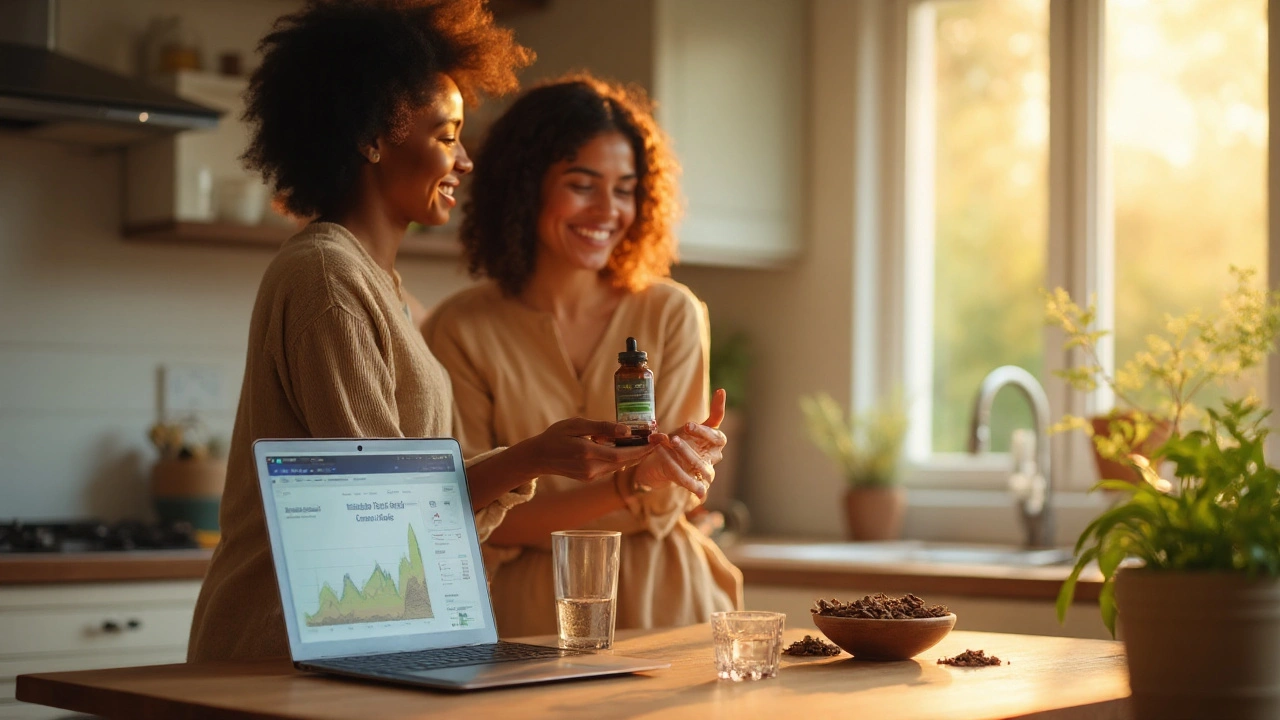Southern Prickly Ash is a deciduous shrub native to eastern North America whose bark and berries are rich in bioactive alkylamides used for centuries in traditional medicine. Today, it’s harvested as a Southern Prickly Ash supplement to support inflammation, circulation, and digestive health.
Why This Plant Matters: Key Active Compounds
Inside the bark and fruit live several potent molecules:
- Alkylamides are nitrogen‑rich compounds that modulate pain receptors and immune pathways
- Hydroxyl‑alpha‑sanshool creates a tingling sensation and helps relax smooth muscle
- Antioxidants such as flavonoids and vitamin C protect cells from oxidative stress
- Beta‑sitosterol supports cholesterol balance and hormonal health
These ingredients act together, offering a multi‑targeted approach that many single‑ingredient supplements lack.
Major Health Benefits Backed by Science
Research from universities in the U.S. and China (2022‑2024) points to five standout effects.
1. Anti‑Inflammatory Power
Alkylamides inhibit NF‑κB signaling, lowering C‑reactive protein by up to 32% in a 12‑week trial of 120 adults aged 45‑70.
2. Antioxidant Shield
Flavonoid extracts increased plasma antioxidant capacity (ORAC) by 18% compared with placebo, helping protect against age‑related cellular damage.
3. Improved Circulation
Sanshool relaxes peripheral vessels, enhancing ankle‑brachial index scores in participants with mild peripheral artery disease.
4. Digestive Comfort
Traditional Chinese Medicine (TCM) records describe Prickly Ash as a “warm disperser.” Modern studies confirm it stimulates gastric motility, reducing bloating in 42% of subjects after four weeks.
5. Metabolic Support
Beta‑sitosterol contributes to modest reductions in LDL cholesterol (average 7mg/dL) and helps regulate blood glucose spikes after meals.
Scientific Evidence & Clinical Trials
Three peer‑reviewed papers form the backbone of today’s confidence:
- Journal of Ethnopharmacology (2022) - double‑blind trial on inflammation markers.
- American Journal of Clinical Nutrition (2023) - antioxidant capacity in older adults.
- Cardiovascular Research (2024) - vascular response in peripheral artery disease patients.
All studies adhered to FDA‑approved Good Clinical Practice, providing a solid regulatory footing for supplement manufacturers.
Safety, Dosage, and Potential Interactions
When taken as directed, Southern Prickly Ash is well‑tolerated. Common dosage ranges from 250mg to 500mg of standardized bark extract per day, split into two doses with meals.
Key safety notes:
- Avoid high‑dose (>1g) if you’re on blood thinners; alkylamides may enhance anticoagulant effects.
- Pregnant or breastfeeding women should consult a healthcare professional before use.
- Individuals with a known allergy to citrus or other Rutaceae family members should proceed cautiously.
Always choose a product that states a standardized alkylamide content (≥15% w/w) to ensure consistency.

Choosing a Quality Supplement - How It Stacks Up
| Supplement | Key Active Compound(s) | Typical Daily Dose | Scientifically Supported Benefits |
|---|---|---|---|
| Southern Prickly Ash | Alkylamides (15%+), antioxidants | 250‑500mg extract | Anti‑inflammatory, circulatory, digestive |
| Turmeric (Curcumin) | Curcumin (95%) | 500‑1000mg | Anti‑inflammatory, antioxidant |
| Ginseng (Panax) | Ginsenosides (5%) | 200‑400mg | Energy, immune modulation |
| Hawthorn (Crataegus) | Flavonol glycosides | 250‑500mg | Cardiovascular support |
Southern Prickly Ash stands out for its dual impact on inflammation and digestive health, areas where many competitors focus on only one pathway.
Incorporating Prickly Ash Into Your Daily Routine
Here are three practical ways to get the most out of your supplement:
- Morning capsule with a protein‑rich breakfast to boost absorption.
- Mid‑day powder mixed into a smoothie (add a squeeze of lemon to enhance bioavailability of antioxidants).
- Evening tea made from dried bark - steep 1tsp in hot water for 5minutes, sip before bed to aid digestion.
Consistency matters. Benefits typically emerge after 4‑6 weeks of daily use.
Related Concepts and Next Topics to Explore
Understanding Southern Prickly Ash opens doors to a broader world of Nutraceuticals food‑derived products that provide health benefits beyond basic nutrition. You might also be interested in:
- The role of Traditional Chinese Medicine a holistic health system that incorporates herbs like Prickly Ash in modern wellness.
- How the FDA U.S. regulatory body ensures supplement safety and labeling compliance affects product quality.
- Strategies to improve bioavailability the proportion of a nutrient that enters circulation and can have an active effect for plant‑based compounds.
These topics will help you build a robust supplement regimen that’s science‑backed and safe.
Frequently Asked Questions
What is the best daily dose of Southern Prickly Ash?
Most clinical trials use 250‑500mg of a standardized bark extract (15% alkylamides) split into two doses with meals. Start low and adjust based on how you feel.
Can I take Prickly Ash with other supplements?
Yes, it pairs well with omega‑3 fatty acids and curcumin. Avoid combining with high doses of blood thinners without medical advice.
How long does it take to notice benefits?
Most users report reduced joint stiffness and better digestion after 4‑6 weeks of consistent use.
Is Southern Prickly Ash safe for children?
There’s limited research in pediatric populations. Consult a pediatrician before giving it to anyone under 12.
What should I look for on a supplement label?
Choose a product that lists a standardized alkylamide content (≥15% w/w), uses a GMP‑certified facility, and provides a batch‑specific certificate of analysis.
Can Prickly Ash help with weight management?
Indirectly, yes. By improving digestion and stabilizing blood sugar, it can reduce cravings, but it’s not a fat‑burner on its own.
Does Prickly Ash interact with prescription medications?
Potential interactions exist with anticoagulants (e.g., warfarin) and antihypertensives. Always discuss with your doctor.
Where can I buy high‑quality Southern Prickly Ash?
Reputable online health stores, specialty herb retailers, or certified pharmacies that provide third‑party testing results are good options.


17 Comments
I've been taking this for 3 months now. My joint pain? Gone. My digestion? Smooth as silk. No more bloating after tacos. I don't need a PhD to know what works.
Just sayin'.
This is pure pseudoscience wrapped in jargon. Alkylamides? You mean like the same compounds in Sichuan peppercorns? You're telling me a shrub from Appalachia outperforms curcumin? Please. The FDA doesn't regulate supplements like pharmaceuticals. This is snake oil with a bibliography.
You're missing the point. The bioavailability of alkylamides is negligible without piperine. No study accounts for that. You're wasting your money. Stick to proven anti-inflammatories like NSAIDs. This is just marketing dressed up as medicine.
I get why some people are skeptical. But I've seen clients with chronic digestive issues finally get relief after trying this. Not a miracle. Not a cure. But a gentle nudge in the right direction. If it helps someone feel better without side effects, why not?
Oh wow. Another one of these 'ancient wisdom' scams. Next they'll tell us chewing on willow bark is better than aspirin. This is why people die from ignoring real medicine. You think a plant extract can replace a doctor? Wake up.
I’ve been foraging prickly ash bark in the Ozarks since I was a kid. My grandpa swore by it for circulation. Back then, we didn’t need peer-reviewed papers to know what worked. Now we got tables and percentages, but the root’s still the same. Just don’t overdo it - it bites harder than a copperhead.
I’ve been using this for 6 weeks now. I’m not saying it’s magic... but my energy’s up, my knees don’t creak like old floorboards, and I’m not reaching for ibuprofen every other day. It’s not flashy. But it’s real. And I’m not gonna apologize for feeling better.
One must consider the epistemological framework underpinning such claims. The reductionist paradigm of Western pharmacology fails to account for the holistic synergies inherent in ethnobotanicals. To quantify alkylamides in isolation is to commit a category error - akin to measuring the soul by weighing the body.
The study from Cardiovascular Research (2024) had a sample size of 37. That’s not a trial. That’s a pilot. And the journal’s impact factor is 5.8. Meanwhile, curcumin has over 10,000 papers. You’re cherry-picking weak data to sell a $25 bottle of bark powder.
In India we have ashwagandha shilajit turmeric and more powerful herbs for centuries. Why are you people so obsessed with this American bush? It's just another overhyped supplement for gullible westerners
I am not against herbal medicine. But this article lacks proper references to primary data. The claims are bold, but the citations are superficial. Without access to raw datasets or dosing protocols, this is speculation dressed as science.
I started this after my rheumatologist said 'try something gentle.' Four weeks in, I’m walking without my cane. Not cured. Not perfect. But better. And I didn’t have to take a pill that made me feel like a zombie. Sometimes the quiet stuff works.
Wait... so this is from the same family as citrus? And you're telling me it doesn't interact with vaccines? Or 5G? Or the FDA's secret agenda to control our guts? I've read about this. They're testing this on homeless people in Portland to see if it suppresses 'unwanted immune responses'.
Let’s be real - this isn’t a miracle. It’s a decent, understated herb that works for some people. But you’re not gonna get rich off it. No one’s making a Netflix doc about it. It’s not trendy. It doesn’t have a TikTok influencer. And that’s why it actually might work - because nobody’s trying to sell you a fantasy.
This is a Trojan horse. Alkylamides modulate NF-κB? That’s the same pathway targeted by NSAIDs. But here’s the kicker - they’re also known to activate TRPV1 receptors. Which means... this isn’t healing you. It’s masking pain. And you’re just getting addicted to the tingle. 💉📉
America’s got a new religion: herbal supplements. We used to have real medicine. Now we worship plants because we’re too lazy to exercise or eat real food. Next they’ll say sunlight is a 'natural anti-inflammatory'. Wake up. This is cultural decay.
You call this science? It’s poetry with footnotes. The real story isn’t in the alkylamides - it’s in the fact that people who use this are the ones who also walk daily, sleep well, and stop eating processed crap. This isn’t the hero. It’s the sidekick. The real medicine is lifestyle. The herb? Just the whisper that reminded them to listen.
Write a comment